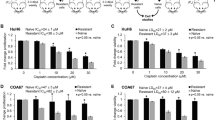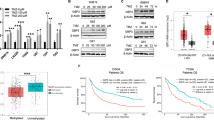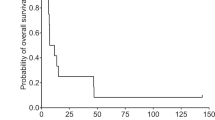Abstract
The median survival for glioblastoma patients is ~15 months despite aggressive surgery and radio-chemotherapy approaches. Thus, developing new therapeutics is necessary to improve the treatment of these invasive brain tumors, which are known to show high levels of the eukaryotic initiation factor, eIF4E, a potent oncogene. Ribavirin, the only clinically approved drug known to target eIF4E, is an anti-viral molecule currently used in hepatitis C treatment. Here, we report the effect of ribavirin on proliferation, cell cycle, cell death and migration of several human and murine glioma cell lines, as well as human glioblastoma stem-like cells, in vitro. In addition, we tested ribavirin efficacy in vivo, alone and in combination with temozolomide and radiation. Our work showed that ribavirin inhibits glioma cell growth and migration, and increases cell cycle arrest and cell death, potentially through modulation of the eIF4E, EZH2 and ERK pathways. We also demonstrate that ribavirin treatment in combination with temozolomide or irradiation increases cell death in glioma cells. Finally and most importantly, ribavirin treatment in vivo significantly enhances chemo-radiotherapy efficacy and improves survival of rats and mice orthotopically implanted with gliosarcoma tumors or glioma stem-like cells, respectively. On the basis of these results, we propose that ribavirin represents a new therapeutic option for glioblastoma patients as an enhancer of the cytotoxic effects of temozolomide and radiotherapy.
This is a preview of subscription content, access via your institution
Access options
Subscribe to this journal
Receive 50 print issues and online access
$259.00 per year
only $5.18 per issue
Buy this article
- Purchase on Springer Link
- Instant access to full article PDF
Prices may be subject to local taxes which are calculated during checkout







Similar content being viewed by others
References
Eggleston M . Clinical review of ribavirin. Infect Control 1987; 8: 215–218.
Paeshuyse J, Dallmeier K, Neyts J . Ribavirin for the treatment of chronic hepatitis C virus infection: a review of the proposed mechanisms of action. Curr Opin Virol 2012; 1: 590–598.
Zopf S, Kremer AE, Neurath MF, Siebler J . Advances in hepatitis C therapy: what is the current state—what come's next? World J Hepatol 2016; 8: 139–147.
Loustaud-Ratti V, Debette-Gratien M, Jacques J, Alain S, Marquet P, Sautereau D et al. Ribavirin: past, present and future. World J Hepatol 2016; 8: 123–130.
Borden KL, Culjkovic-Kraljacic B . Ribavirin as an anti-cancer therapy: acute myeloid leukemia and beyond? Leuk Lymphoma 2010; 51: 1805–1815.
De la Cruz-Hernandez E, Medina-Franco JL, Trujillo J, Chavez-Blanco A, Dominguez-Gomez G, Perez-Cardenas E et al. Ribavirin as a tri-targeted antitumor repositioned drug. Oncol Rep 2015; 33: 2384–2392.
Assouline S, Culjkovic-Kraljacic B, Bergeron J, Caplan S, Cocolakis E, Lambert C et al. A phase I trial of ribavirin and low-dose cytarabine for the treatment of relapsed and refractory acute myeloid leukemia with elevated eIF4E. Haematologica 2014; 100: e7–e9.
Pettersson F, Yau C, Dobocan MC, Culjkovic-Kraljacic B, Retrouvey H, Puckett R et al. Ribavirin treatment effects on breast cancers overexpressing eIF4E, a biomarker with prognostic specificity for luminal B-type breast cancer. Clin Cancer Res 2011; 17: 2874–2884.
Kokeny S, Papp J, Weber G, Vaszko T, Carmona-Saez P, Olah E . Ribavirin acts via multiple pathways in inhibition of leukemic cell proliferation. Anticancer Res 2009; 29: 1971–1980.
Olah E, Kokeny S, Papp J, Bozsik A, Keszei M . Modulation of cancer pathways by inhibitors of guanylate metabolism. Adv Enzyme Regul 2006; 46: 176–190.
Shi F, Len Y, Gong Y, Shi R, Yang X, Naren D et al. Ribavirin inhibits the activity of mTOR/eIF4E, ERK/Mnk1/eIF4E signaling pathway and synergizes with tyrosine kinase inhibitor imatinib to impair Bcr-Abl mediated proliferation and apoptosis in Ph+ leukemia. PLoS One 2015; 10: e0136746.
Kentsis A, Topisirovic I, Culjkovic B, Shao L, Borden KL . Ribavirin suppresses eIF4E-mediated oncogenic transformation by physical mimicry of the 7-methyl guanosine mRNA cap. Proc Natl Acad Sci USA 2004; 101: 18105–18110.
Kentsis A, Volpon L, Topisirovic I, Soll CE, Culjkovic B, Shao L et al. Further evidence that ribavirin interacts with eIF4E. RNA 2005; 11: 1762–1766.
Pettersson F, Del Rincon SV, Miller WH Jr . Eukaryotic translation initiation factor 4E as a novel therapeutic target in hematological malignancies and beyond. Expert Opin Ther Targets 2014; 18: 1035–1048.
Gu X, Jones L, Lowery-Norberg M, Fowler M . Expression of eukaryotic initiation factor 4E in astrocytic tumors. Appl Immunohistochem Mol Morphol 2005; 13: 178–183.
Ruggero D, Pandolfi PP . Does the ribosome translate cancer? Nat Rev Cancer 2003; 3: 179–192.
Louis DN, Perry A, Reifenberger G, von Deimling A, Figarella-Branger D, Cavenee WK et al. The 2016 world health organization classification of tumors of the central nervous system: a summary. Acta Neuropathol 2016; 131: 803–820.
Stupp R, Hegi ME, Mason WP, van den Bent MJ, Taphoorn MJ, Janzer RC et al. Effects of radiotherapy with concomitant and adjuvant temozolomide versus radiotherapy alone on survival in glioblastoma in a randomised phase III study: 5-year analysis of the EORTC-NCIC trial. Lancet Oncol 2009; 10: 459–466.
Stupp R, Mason WP, van den Bent MJ, Weller M, Fisher B, Taphoorn MJ et al. Radiotherapy plus concomitant and adjuvant temozolomide for glioblastoma. N Engl J Med 2005; 352: 987–996.
McGirt MJ, Than KD, Weingart JD, Chaichana KL, Attenello FJ, Olivi A et al. Gliadel (BCNU) wafer plus concomitant temozolomide therapy after primary resection of glioblastoma multiforme. J Neurosurg 2009; 110: 583–588.
Assouline S, Culjkovic B, Cocolakis E, Rousseau C, Beslu N, Amri A et al. Molecular targeting of the oncogene eIF4E in acute myeloid leukemia (AML): a proof-of-principle clinical trial with ribavirin. Blood 2009; 114: 257–260.
Pettersson F, Del Rincon SV, Emond A, Huor B, Ngan E, Ng J et al. Genetic and pharmacologic inhibition of eIF4E reduces breast cancer cell migration, invasion, and metastasis. Cancer Res 2015; 75: 1102–1112.
Ogino A, Sano E, Ochiai Y, Yamamuro S, Tashiro S, Yachi K et al. Efficacy of ribavirin against malignant glioma cell lines. Oncol Lett 2014; 8: 2469–2474.
Richard SM, Martinez Marignac VL . Sensitization to oxaliplatin in HCT116 and HT29 cell lines by metformin and ribavirin and differences in response to mitochondrial glutaminase inhibition. J Cancer Res Ther 2015; 11: 336–340.
Vignon C, Debeissat C, Georget MT, Bouscary D, Gyan E, Rosset P et al. Flow cytometric quantification of all phases of the cell cycle and apoptosis in a two-color fluorescence plot. PLoS One 2013; 8: e68425.
Zambon AC . Use of the Ki67 promoter to label cell cycle entry in living cells. Cytometry A 2010; 77: 564–570.
Sesen J, Dahan P, Scotland SJ, Saland E, Dang VT, Lemarie A et al. Metformin inhibits growth of human glioblastoma cells and enhances therapeutic response. PLoS One 2015; 10: e0123721.
Scheidel LM, Durbin RK, Stollar V . Sindbis virus mutants resistant to mycophenolic acid and ribavirin. Virology 1987; 158: 1–7.
Bertolini F, Sukhatme VP, Bouche G . Drug repurposing in oncology–-patient and health systems opportunities. Nat Rev Clin Oncol 2015; 12: 732–742.
Papanagnou P, Stivarou T, Tsironi M . Unexploited antineoplastic effects of commercially available anti-diabetic drugs. Pharmaceuticals 2016; 9: 24.
Tamburini J, Green AS, Chapuis N, Bardet V, Lacombe C, Mayeux P et al. Targeting translation in acute myeloid leukemia: a new paradigm for therapy? Cell Cycle 2009; 8: 3893–3899.
Ge Y, Zhou F, Chen H, Cui C, Liu D, Li Q et al. Sox2 is translationally activated by eukaryotic initiation factor 4E in human glioma-initiating cells. Biochem Biophys Res Commun 2010; 397: 711–717.
Vallee S, Fouchier F, Braguer D, Marvaldi J, Champion S . Ribavirin-induced resistance to heat shock, inhibition of the Ras-Raf-1 pathway and arrest in G(1). Eur J Pharmacol 2000; 404: 49–62.
Dubois L, Magagnin MG, Cleven AH, Weppler SA, Grenacher B, Landuyt W et al. Inhibition of 4E-BP1 sensitizes U87 glioblastoma xenograft tumors to irradiation by decreasing hypoxia tolerance. Int J Radiat Oncol Biol Phys 2009; 73: 1219–1227.
Furic L, Rong L, Larsson O, Koumakpayi IH, Yoshida K, Brueschke A et al. eIF4E phosphorylation promotes tumorigenesis and is associated with prostate cancer progression. Proc Natl Acad Sci USA 2010; 107: 14134–14139.
Grzmil M, Huber RM, Hess D, Frank S, Hynx D, Moncayo G et al. MNK1 pathway activity maintains protein synthesis in rapalog-treated gliomas. J Clin Invest 2014; 124: 742–754.
Hsieh AC, Ruggero D . Targeting eukaryotic translation initiation factor 4E (eIF4E) in cancer. Clin Cancer Res 2010; 16: 4914–4920.
Mijatovic S, Maksimovic-Ivanic D, Radovic J, Miljkovic D, Harhaji L, Vuckovic O et al. Anti-glioma action of aloe emodin: the role of ERK inhibition. Cell Mol Life Sci 2005; 62: 589–598.
Sunayama J, Matsuda K, Sato A, Tachibana K, Suzuki K, Narita Y et al. Crosstalk between the PI3K/mTOR and MEK/ERK pathways involved in the maintenance of self-renewal and tumorigenicity of glioblastoma stem-like cells. Stem Cells 2010; 28: 1930–1939.
Chen D, Zuo D, Luan C, Liu M, Na M, Ran L et al. Glioma cell proliferation controlled by ERK activity-dependent surface expression of PDGFRA. PLoS One 2014; 9: e87281.
Alimova I, Birks DK, Harris PS, Knipstein JA, Venkataraman S, Marquez VE et al. Inhibition of EZH2 suppresses self-renewal and induces radiation sensitivity in atypical rhabdoid teratoid tumor cells. Neuro Oncol 2013; 15: 149–160.
Fan TY, Wang H, Xiang P, Liu YW, Li HZ, Lei BX et al. Inhibition of EZH2 reverses chemotherapeutic drug TMZ chemosensitivity in glioblastoma. Int J Clin Exp Pathol 2014; 7: 6662–6670.
Kim SH, Joshi K, Ezhilarasan R, Myers TR, Siu J, Gu C et al. EZH2 protects glioma stem cells from radiation-induced cell death in a MELK/FOXM1-dependent manner. Stem Cell Rep 2015; 4: 226–238.
Suva ML, Riggi N, Janiszewska M, Radovanovic I, Provero P, Stehle JC et al. EZH2 is essential for glioblastoma cancer stem cell maintenance. Cancer Res 2009; 69: 9211–9218.
Zhang W, Lv S, Liu J, Zang Z, Yin J, An N et al. PCI-24781 down-regulates EZH2 expression and then promotes glioma apoptosis by suppressing the PIK3K/Akt/mTOR pathway. Genet Mol Biol 2014; 37: 716–724.
Myung JK, Choi SA, Kim SK, Wang KC, Park SH . Snail plays an oncogenic role in glioblastoma by promoting epithelial mesenchymal transition. Int J Clin Exp Pathol 2014; 7: 1977–1987.
Savary K, Caglayan D, Caja L, Tzavlaki K, Bin Nayeem S, Bergstrom T et al. Snail depletes the tumorigenic potential of glioblastoma. Oncogene 2013; 32: 5409–5420.
Colombo G, Lorenzini L, Zironi E, Galligioni V, Sonvico F, Balducci AG et al. Brain distribution of ribavirin after intranasal administration. Antiviral Res 2011; 92: 408–414.
Jeulin H, Venard V, Carapito D, Finance C, Kedzierewicz F . Effective ribavirin concentration in mice brain using cyclodextrin as a drug carrier: evaluation in a measles encephalitis model. Antiviral Res 2009; 81: 261–266.
Dadgostari S, Xu C, Yeh LT, Lin CC, Vitarella D . Viramidine demonstrates better safety than ribavirin in monkeys but not rats. Drug Chem Toxicol 2004; 27: 191–211.
Harvie P, Omar RF, Dusserre N, Desormeaux A, Gourde P, Tremblay M et al. Antiviral efficacy and toxicity of ribavirin in murine acquired immunodeficiency syndrome model. J Acquir Immune Defic Syndr Hum Retrovirol 1996; 12: 451–461.
Narayana K, D'Souza UJ, Seetharama Rao KP . The genotoxic and cytotoxic effects of ribavirin in rat bone marrow. Mutat Res 2002; 521: 179–185.
Russmann S, Grattagliano I, Portincasa P, Palmieri VO, Palasciano G . Ribavirin-induced anemia: mechanisms, risk factors and related targets for future research. Curr Med Chem 2006; 13: 3351–3357.
Hayman TJ, Williams ES, Jamal M, Shankavaram UT, Camphausen K, Tofilon PJ . Translation initiation factor eIF4E is a target for tumor cell radiosensitization. Cancer Res 2012; 72: 2362–2372.
Zekri AR, Bahnasy AA, Shoeab FE, Mohamed WS, El-Dahshan DH, Ali FT et al. Methylation of multiple genes in hepatitis C virus associated hepatocellular carcinoma. J Adv Res 2015; 5: 27–40.
Sesen J, Cammas A, Scotland SJ, Elefterion B, Lemarie A, Millevoi S et al. Int6/eIF3e is essential for proliferation and survival of human glioblastoma cells. Int J Mol Sci 2014; 15: 2172–2190.
Piccirillo SG, Combi R, Cajola L, Patrizi A, Redaelli S, Bentivegna A et al. Distinct pools of cancer stem-like cells coexist within human glioblastomas and display different tumorigenicity and independent genomic evolution. Oncogene 2009; 28: 1807–1811.
Mangraviti A, Tzeng SY, Gullotti D, Kozielski KL, Kim JE, Seng M et al. Non-virally engineered human adipose mesenchymal stem cells produce BMP4, target brain tumors, and extend survival. Biomaterials 2016; 100: 53–66.
Scotland S, Saland E, Skuli N, de Toni F, Boutzen H, Micklow E et al. Mitochondrial energetic and AKT status mediate metabolic effects and apoptosis of metformin in human leukemic cells. Leukemia 27: 2129–2138.
Skuli N, Liu L, Runge A, Wang T, Yuan L, Patel S et al. Endothelial deletion of hypoxia-inducible factor-2alpha (HIF-2alpha) alters vascular function and tumor angiogenesis. Blood 2009; 114: 469–477.
Skuli N, Majmundar AJ, Krock BL, Mesquita RC, Mathew LK, Quinn ZL et al. Endothelial HIF-2alpha regulates murine pathological angiogenesis and revascularization processes. J Clin Invest 2012; 122: 1427–1443.
Gallia GL, Tyler BM, Hann CL, Siu IM, Giranda VL, Vescovi AL et al. Inhibition of Akt inhibits growth of glioblastoma and glioblastoma stem-like cells. Mol Cancer Ther 2009; 8: 386–393.
Wicks RT, Azadi J, Mangraviti A, Zhang I, Hwang L, Joshi A et al. Local delivery of cancer-cell glycolytic inhibitors in high-grade glioma. Neuro Oncol 2014; 17: 70–80.
Acknowledgements
We thank the Hunterian Neurosurgical Research Laboratory, Dr Thomas Simon for helpful comments, and Mr and Mrs Peter Jennison and Mr and Mrs Josh Fidler for their kind and generous support. This work was supported by INSERM (Grant number: U1037SPDOTSKULI).
Author information
Authors and Affiliations
Corresponding author
Ethics declarations
Competing interests
The authors declare no conflict of interest.
Additional information
Supplementary Information accompanies this paper on the Oncogene website
Supplementary information
Rights and permissions
About this article
Cite this article
Volpin, F., Casaos, J., Sesen, J. et al. Use of an anti-viral drug, Ribavirin, as an anti-glioblastoma therapeutic. Oncogene 36, 3037–3047 (2017). https://doi.org/10.1038/onc.2016.457
Received:
Revised:
Accepted:
Published:
Issue Date:
DOI: https://doi.org/10.1038/onc.2016.457
This article is cited by
-
Drug repurposing against COVID-19: focus on anticancer agents
Journal of Experimental & Clinical Cancer Research (2020)
-
The immuno-oncological challenge of COVID-19
Nature Cancer (2020)
-
Targeting EIF4E signaling with ribavirin in infant acute lymphoblastic leukemia
Oncogene (2019)



